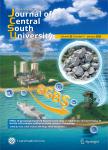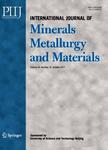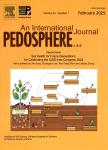
T=题名(书名、题名),A=作者(责任者),K=主题词,P=出版物名称,PU=出版社名称,O=机构(作者单位、学位授予单位、专利申请人),L=中图分类号,C=学科分类号,U=全部字段,Y=年(出版发行年、学位年度、标准发布年)
AND代表“并且”;OR代表“或者”;NOT代表“不包含”;(注意必须大写,运算符两边需空一格)
范例一:(K=图书馆学 OR K=情报学) AND A=范并思 AND Y=1982-2016
范例二:P=计算机应用与软件 AND (U=C++ OR U=Basic) NOT K=Visual AND Y=2011-2016

摘要:INTRODUCTIONThemainprocesesinzinchydrometalurgyareleaching,purificationandelectrolysis[1,2].Theleachinginvolvesdisolvingzinc?..

摘要:Some effective parameters on the copper extraction from Kiire chalcopyrite concentrate were optimized by using response surface methodology (RSM). Experiments designed by RSM were carried out in the presence of ammonium persulfate (APS) and different types of impeller in an autoclave system. Ammonium persulfate concentration and leaching temperature were defined numerically and three types of impellers were defined categorically as independent variables using experimental design software. The optimum condition for copper extraction from the chalcopyrite concentrate is found to be ammonium persulfate concentration of 277.77 kg/m3, leaching temperature of 389.98 K and wheel type of impeller. The proposed model equation using RSM has shown good agreement with the experimental data, with correlation coefficients R2 and RaZaj for the model as 0.89 and 0.84, respectively.

摘要:To solve the problem of slow leaching speed of copper,surfactant was added into lixivium as leaching agent in the *** on physical chemistry and seepage flow mechanics,the leaching mechanics of surfactant was *** solution surface tension and surfactant adsorbing on the surface of ore have a significant impact on the surface wetting *** leaching rate for response,the study screened out three main factors by Plackett-Burman design method:the sulfuric acid concentration,surfactant concentration and *** these three factors,the surfactant concentration is the most important contributor to leaching *** obtaining the experiment center by the steepest ascent experiment,a continuous variable surface model was built by response surface *** solving quadratic polynomial equation,optimal conditions for leaching were finally obtained as follows:the sulfuric acid concentration was 60 g/L,the surfactant concentration was 0.00914 mol/L,and the temperature was 45 °*** leaching rate was 66.81% in the optimized leaching conditions,which was close to the predicted value,showing that regression result was good.

摘要:Due to the complex chemical composition of nickel ores, the requests for the decrease of production costs, and the increase of nickel extraction in the existing depletion of high-grade sulfide ores around the world, computer modeling of nickel ore leaching process be- came a need and a challenge. In this paper, the design of experiments (DOE) theory was used to determine the optimal experimental design plan matrix based on the D optimality criterion. In the high-pressure sulfuric acid leaching (HPSAL) process for nickel laterite in "Rudjinci" ore in Serbia, the temperature, the sulfuric acid to ore ratio, the stirring speed, and the leaching time as the predictor variables, and the degree of nickel extraction as the response have been considered. To model the process, the multiple linear regression (MLR) and response surface method (RSM), together with the two-level and four-factor full factorial central composite design (CCD) plan, were used. The proposed re- gression models have not been proven adequate. Therefore, the artificial neural network (ANN) approach with the same experimental plan was used in order to reduce operational costs, give a better modeling accuracy, and provide a more successful process optimization. The model is based on the multi-layer neural networks with the back-propagation (BP) learning algorithm and the bipolar sigmoid activation function.

摘要:Although nitrogen (N) loss through runoff and leaching from croplands is suspected to contribute to the deterioration of surrounding water systems, there is no conclusive evidence for paddy soils to prove this hypothesis. In this study, field plot experiments were conducted to investigate N losses through runoff and leaching for two consecutive years with 3 N fertilization rates in rice (Oryza sativa L.)-wheat (Triticum aestivum L.) rotations in the Taihu Lake region, China. A water collection system was designed to collect runoff and leachates for both the rice and wheat seasons. Results showed that dissolved N (DN), rather than particulate N (PN), was the main form of N loss by runoff. The NO3^--N concentration in runoff was between 0.1 and 43.7 mg L^-1, whereas the NH4^+-N concentration ranged from below detection limit to 8.5 mg L^-1. Total N (TN) loads by runoff were 1.0-17.9 and 5.2-38.6 kg ha^-1 during rice and wheat seasons, respectively, and the main loss occurred at the early growing stage of the crops. Nitrogen concentrations in leachates during the rice seasons were below 1.0 mg L^-1 and independent of the N application rate, whereas those during the wheat season increased to 8.2 mg L^-1 and were affected by the fertilizer rate. Annual losses of TN through runoff and leaching were 13.7-48.1 kg ha^-1 from the rice-wheat cropping system, accounting for 5.6%-8.3% of the total applied N. It was concluded that reduction in the N fertilization rate, especially when the crop was small in biomass, could lower the N pollution potential for water systems.

摘要:The application of leaching process to extracting Mn from a low-grade manganese ore was investigated using a software based design of experiments. Four main parameters, i.e. sulfuric acid concentration, oxalic acid concentration, time and temperature were considered in a central composite response surface design. The recoveries of Mn and Fe were selected as response of design. The optimum conditions under which the Mn and Fe recoveries were the highest and the time and temperature were the lowest were determined using statistical analysis and analysis of variance (ANOVA). The results showed that Mn and Fe recoveries were 93.44% and 15.72% under the optimum condition, respectively. Also, sulfuric acid concentration was the most effective parameter affecting the process. The amounts of sulfuric and oxalic acid were obtained to be 7% and 42.50 g/L in optimum condition and the best time and temperature were 65 min and 63 ℃.

摘要:The leaching behavior of Tunceli malachite mineral was investigated in nitric acid solutions by two steps to evaluate the effect of various experimental *** the first step,the optimal conditions for the leaching process were determined,while in the second step,a kinetic evaluation for the process was *** the optimization experiments,the concentration of nitric acid,temperature,stirring speed,and solid-to-liquid ratio were selected as the independent variables,and the central composite design method(CCD)was applied to the experimental *** the end of the experiments,the optimal values for the concentration of nitric acid,temperature,solid-to-liquid ratio and stirring speed were determined to be 0.5 mol/L,50℃,0.004 g/m L and 500 r/min,*** the optimal conditions,the leaching rate was found to be 99%for 120 min of reaction *** the kinetic evaluation tests,the effects of the concentration of nitric acid,temperature,stirring speed,solid-to-liquid ratio and particle size on the leaching rate of copper from malachite were *** these tests,it was determined that the leaching rate increased with the increase in the temperature,acid concentration and stirring speed,and with the decrease in the particle size and solid-to-liquid *** consequence of the kinetic analysis,it was observed that the leaching kinetics followed the mixed kinetic model,and a mathematical model for the leaching process was *** activation energy for this process was calculated to be 36.23 k J/mol.
地址:宁波市钱湖南路8号浙江万里学院(315100)
Tel:0574-88222222
招生:0574-88222065 88222066
Email:yzb@zwu.edu.cn

